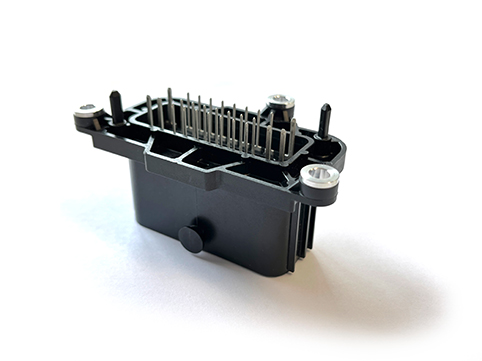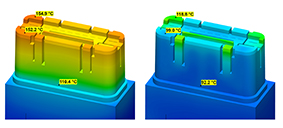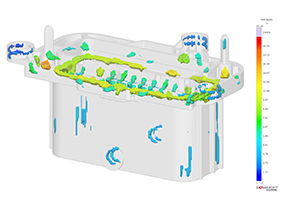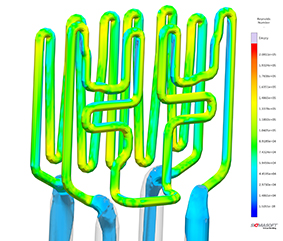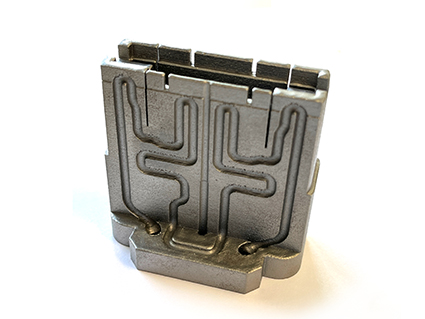Cavity inserts, just print them – Rethinking conformal cooling
Frist published in german at Plastverarbeiter
Justifying additive manufacturing with simulation?
Additive manufacturing has been on everyone's lips for more than a decade, and 3D printing has now become part of everyday production. In addition to prototypes and small series, attention is now also focused on the opportunities that this manufacturing technology offers through completely new possibilities in design and shaping.
In modern injection molding, stable mold temperature control is the basic requirement for a robust process and high component quality. The precise and local temperature control not only affects cycle time but also shrinkage and warpage. The design of the cooling channels in terms of arrangement and flow must therefore be carefully planned. For uniform temperature control, contour-close conformal cooling is recommended, but it can be complex. For the detailed and reliable design of injection mold and process, modern simulation tools like SIGMASOFT® Virtual Molding are indispensable. Here, the mold, including all heating zones, cooling channels, and insulation materials, is operated virtually on the computer with the selected plastic material, accurately simulating each cycle. Defects and quality issues are detected before they occur. Changes and optimizations can be tested virtually before implementation. This is crucial when aiming to offset additional costs through better production results. The following example from connector specialist H&B Electronic demonstrates the capabilities of simulation in the development of an optimized, innovative conformal cooling system for a connector housing (see Figure 1).
Where does the heat go?
In plastic injection molding, the melt is injected into a relatively cold steel injection mold (for example, at around 90 °C) with a material-specific temperature (for PA 66, for instance, approximately 290 °C). During the injection process, the plastic melt begins to transfer heat to the injection mold as soon as it comes into contact with the mold wall. This process continues until the melt solidifies into a solid body and can be removed from the mold. The injection mold must dissipate the heat it receives. This is usually done through cooling channels, i.e. channels in the mold through which a cooling liquid flows.
The heat flow within the mold is significantly influenced by two effects. Firstly, the amount of heat to be dissipated depends on the geometry of the molded part. Thin-walled areas of the component require less heat extraction than thick-walled areas, known as hotspots. Secondly, the drilled cooling channels cannot be placed in the mold in such a way that they ensure uniform heat dissipation throughout all areas of the cavity. Accordingly, in conventionally cooled molds, an inhomogeneous temperature distribution occurs (Figure 2, left). The red areas of the depicted mold insert have a temperature of over 150 °C, whereas the blue areas are at approximately 100 °C. Thus, there is a temperature difference of around 50 °C within the shaping area at the considered time.
The present temperature distribution indicates that there are local areas within the component that cool at different rates. The resulting internal stresses within the component ultimately lead to warpage after demolding. Furthermore, an uneven cooling behavior also extends the cycle time.
Improvement is possible...
The aim in designing mold temperature control is therefore to minimize temperature differences within the mold, especially in the cavity, and to ensure homogeneous heat dissipation. Using simulation, hotspots can be precisely identified (see Figure 3).
If the critical points on the component are known, the design of the channels in the mold can be specifically adapted to these. H&B Electronic relies on metal 3D printing to realize almost freely selectable, near-contour channels - more on this later.
Figure 4 shows such a design of a conformal cooling channel, as it was ultimately actually implemented in the series mold. The result of the Reynolds number is shown. As a reminder: turbulent flow, if this is greater than 2300 - this is desirable for cooling; laminar flow, if less, for good fluid transport. To be on the safe side, H&B has set the limit value at 10,000.
The flow calculation in SIGMASOFT® is carried out considering the following influencing parameters, among others:
- Viscosity of the cooling fluid,
- defined volume flow in l/min and
- geometric progression and surface roughness of the tempering channels.
Designing the flow using simulation
The general requirements for a temperature control system consist of good heat dissipation with the lowest possible pressure loss within the channel and a resulting homogeneous temperature distribution in the component at a given flow rate.
In addition to the Reynolds number, the pressure requirement of the temperature control channel is an important quality criterion (Figure 5). Even though the pressure requirement does not reach a critical value in this example, such simulations provide valuable assistance in the selection of the temperature control device and the feasibility assessment. Last but not least, a low pressure requirement also means an improvement in the energy consumption of the tempering system.
A reduction in the pressure requirement was achieved through three iteration loops by implementing the following measures:
- Significantly increasing the diameter at the inlet and outlet areas
- Increasing the diameter of the entire cooling channel
- Reducing or making the bends in the channel “softer”
During optimization, the pressure loss was reduced from an initial 4.5 to 1.8 bar (see Figure 5).
The images do not show a pipeline, but channels within a block of tool steel. In the computer, this looks like a perfect solution, but in terms of production technology, 3D printing is used here due to its feasibility (Figure 6).
Practical 3D printing in moldmaking
Metal 3D printing used to be limited to the bake hardening steel 1.2709. This material tends not to be used for mold inserts in conventional production due to its disadvantages in terms of thermal properties (e.g. hot hardness) and corrosion resistance. The hot-work mold steel 1.2343 is one of the most popular materials for many tool and mold makers when it comes to the production of mold inserts for plastic injection molds, for example. It enables the reliable processing of technical plastics in large quantities to produce, for example, sophisticated connectors. H&B is one of the few service providers able to reliably manufacture components from this high-carbon tool steel using the laser melting process (LPBF). In terms of material properties such as strength and hardness, the printed components achieve values comparable to those of conventionally manufactured components.
What happens next?
With the help of conformal temperature control, it was possible to achieve more homogeneous and faster heat dissipation (Figure 1, right). Simulation with SIGMASOFT® enabled the advantages of the cooling concept for this and similar tools to be calculated to such an extent that H&B decided to purchase the TruPrint 5000 from TRUMPF. This is also available for customer projects together with the in-house expertise in mold design through simulation. The production of hybrid components, printed on conventionally manufactured steel structures, is just as possible as the production of larger components (up to 270 mm in diameter and 300 mm high). The production of these 3D printed structures is not cheap, but generally pays off in series production thanks to reduced cycle times and improved quality. Thanks to SIGMASOFT®, the associated cost and sustainability benefits can be quantified in advance.
Information:
In the laser melting process (LPBF), metal powder is melted layer by layer using a laser beam. In addition, the locally applied thermal energy causes the immediately adjacent areas that have already been produced to melt again. The resulting partial melt pool ensures a similarly homogeneous and fine-grained microstructure to that of the hot-work tool steel 1.2343 (H11) produced conventionally by electroslag remelting (ESR). H&B Electronic prints exclusively with 1.2343 (H11) and a preheating of the build platform of 500 °C. This reduces the tendency to microcracks and ultimately enables the printed components to be polished..
Authors:
Jan Bayerbach, R&D Manager, /H&B/ Electronic GmbH & Co. KG, Siemensstraße 8, 75392 Deckenpfronn, info@h-und-b.de
Katharina Doetz, Marketing Manager, SIGMA Engineering GmbH, Kackertstraße 16-18, 52072 Aachen, info@sigmasoft.de
News
You are interested in the latest news about SIGMA and SIGMASOFT®? Check our news section to learn more.
About Us
For 20 years we are the expert on all kinds of injection molding simulation. From part to process we help to optimize plastic, rubber, thermoset and PIM applications. Here you can learn more about the company behind SIGMASOFT®.

